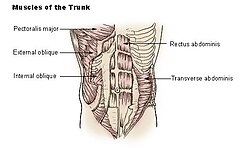Abdominal internal oblique muscle
| Abdominal internal oblique muscle | |
|---|---|

The obliquus internus abdominis.
|
|

Muscles of the trunk.
|
|
| Details | |
| Origin | Inguinal ligament, Iliac crest and the Lumbodorsal fascia. |
| Insertion | Linea alba, Pecten Pubis (via Conjoint tendon) and ribs 10-12. |
| Artery | subcostal arteries. |
| Nerve | Thoracoabdominal nn. (T6-T11), Subcostal n. (T12), Iliohypogastric n. (L1) and Ilioinguinal n. (L1) |
| Actions |
Bilateral: Compresses abdomen Unilateral: ipsilateral trunk rotation |
| Identifiers | |
| Latin | Musculus obliquus internus abdominis |
| TA | A04.5.01.017 |
| FMA | 13891 |
|
Anatomical terms of muscle
[]
|
|
Bilateral: Compresses abdomen
The internal oblique muscle is a muscle in the abdominal wall that lies below the external oblique and just above the transverse abdominal muscles.
Its fibers run perpendicular to the external oblique muscle, beginning in the thoracolumbar fascia of the lower back, the anterior 2/3 of the iliac crest (upper part of hip bone) and the lateral half of the inguinal ligament. The muscle fibers run from these point superiomedially (up and towards midline) to the muscle's insertions on the inferior borders of the 10th through 12th ribs and the linea alba.
In males, the cremaster muscle is also attached to the internal oblique.
The internal oblique is innervated by the lower intercostal nerves, as well as the iliohypogastric nerve and the ilioinguinal nerve.
The internal oblique performs two major functions. Firstly as an accessory muscle of respiration, it acts as an antagonist (opponent) to the diaphragm, helping to reduce the volume of the chest cavity during exhalation. When the diaphragm contracts, it pulls the lower wall of the chest cavity down, increasing the volume of the lungs which then fill with air. Conversely, when the internal obliques contract they compress the organs of the abdomen, pushing them up into the diaphragm which intrudes back into the chest cavity reducing the volume of the air filled lungs, producing an exhalation.
Secondly, its contraction rotates and side-bends the trunk by pulling the rib cage and midline towards the hip and lower back, of the same side. It acts with the external oblique muscle of the opposite side to achieve this torsional movement of the trunk. For example, the right internal oblique and the left external oblique contract as the torso flexes and rotates to bring the left shoulder towards the right hip. For this reason, the internal obliques are referred to as "same side rotators."
...
Wikipedia
